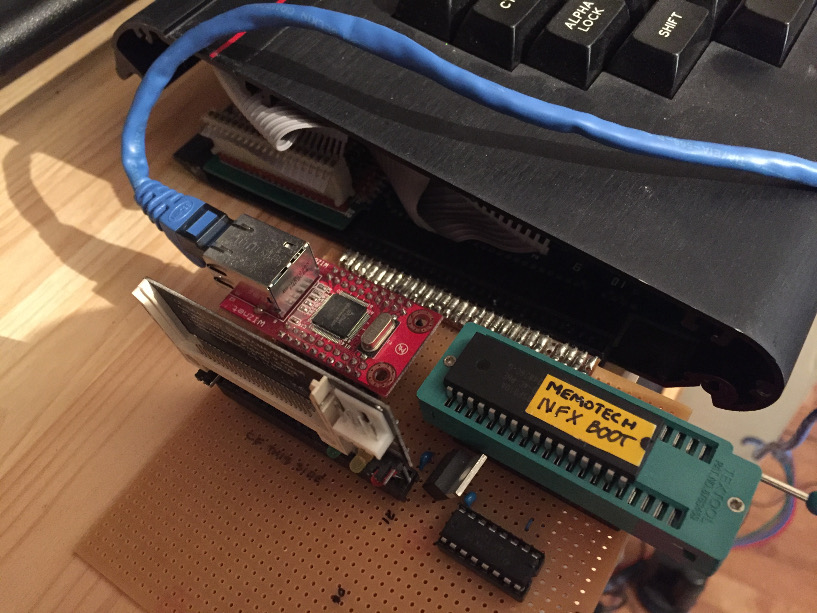

The NFX has an IDE Compact Flash a ROM with 40 column CP/M on it. It also has a Wiznet W5100 which is what gives it physical connectivity to Ethernet.
At Memofest 2017, Martin handed an NFX to me (Andy), and suggested I try to get an MTX onto the Internet.
So I developed a program called NFX.COM to do this.
It includes an implementation of the chargen
service, running on port 19, and to see this, you can
$ nc 192.168.1.123 19 !"#$%&'()*+,-./0123456789:;<=>?@ABCDEFGHIJKLMNOPQRSTUVWXYZ[\]^_`abcdefgh "#$%&'()*+,-./0123456789:;<=>?@ABCDEFGHIJKLMNOPQRSTUVWXYZ[\]^_`abcdefghi #$%&'()*+,-./0123456789:;<=>?@ABCDEFGHIJKLMNOPQRSTUVWXYZ[\]^_`abcdefghij ^C
It includes an implementation of the echo
service, running on port 7, and to see this, you can
$ nc 192.168.1.123 7 Hello World Hello World ^D
It can only serve requests to files in the root directory,
as CP/M has no directory structure.
Filenames must be 8.3 format.
If the filename is omitted, it defaults to INDEX.HTM.
It knows the MIME types of a quite a few common file types found on CP/M filesystems, and a few common internet related types such as CSS, JS, GIF, PNG, JPG, TIF, ...
If it spots that it is returning a textual file, then it looks for the ^Z character, and stops returning file content.
If the HTTP service is started with POSTs and DELETEs allowed, then it is possible to upload content to the web server, or delete it :-
$ curl -X POST --data-binary @newpage.htm http://192.168.1.123/newpage.htm $ curl -X DELETE http://192.168.1.123/newpage.htm
Note that uploaded content is padded with ^Z characters to complete the last 128 byte sector. CP/M files are always an integer number of 128 byte sectors long. ^Z is chosen, just in case the content is textual.
I constructed an embedded real-time OS kernel. This uses a "fibrous" programming model to allow multiple concurrent activities to proceed "in parallel". This is because we can be processing several network sockets at once.
In a fibrous model, many calls made to lower level services are passed a routine to call when the work is done, and a value to pass to it. They return immediately, having instructed but not completed the work. At a given level of coding, a thread of execution becomes a sequence of fibers, which are called one after another, often with gaps and other work interleaving them.
On top of this I constructed a library for interacting with the W5100, and network layer above of that. The network layer also provides a "fibrous" interface. So typically code says things like "listen for a connection, and call this fiber when done".
I found that SDCC doesn't generate particularly optimised code for doing block I/O transfers, so I recoded this part in assembler. This gave a 5% speed boost.
Finally, on top of this I created the services, which primarily just use the network layer.
NFX can be downloaded from
http://www.nyangau.org/nfx/nfx.zip.
Copying of this program is encouraged, as it is fully public domain. Even the source code is included in the package. It was created on the authors time and equipment. Caveat Emptor.
The author of NFX and this documentation is Andy Key
(email andy.z.key@googlemail.com).
{{{ Andy